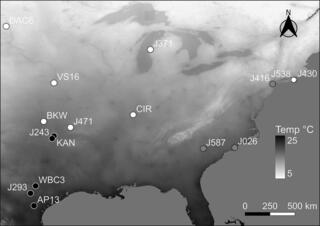Cold acclimation threshold induction temperatures of switchgrass ecotypes grown under a long and short photoperiod
I.R. Willick and D.B. Lowry "Cold acclimation threshold induction temperatures of switchgrass ecotypes grown under a long and short photoperiod" Physiologia Plantarum 174 (2022) [DOI: 10.1111/ppl.13812]
Plants can cold acclimate to enhance their freezing tolerance by sensing declining temperature and photoperiod cues. However, the factors influencing genotypic variation in the induction of cold acclimation are poorly understood among perennial grasses. We hypothesized that the more northern upland switchgrass (Panicum virgatum L.) ecotype develops a higher degree of freezing tolerance by initiating cold acclimation at higher temperatures as compared with the coastal and southern lowland ecotypes. First, we determined the optimal method for assessing freezing tolerance and the length of exposure to 8/4°C required to induce the maximum level of freezing tolerance in the most northern upland and most southern lowland genotypes. We characterized the maximum freezing tolerance of eight uplands, three coastal and five lowland genotypes grown for 21 days at 8/4°C and a 10 or 16 h photoperiod. Next, we identified the temperature required to induce cold acclimation by exposing the 16 genotypes for 7 days at 20–6°C constant temperatures under a 10 or 16 h photoperiod. Cold acclimation initiated at temperatures 5 and 7°C higher in upland than in coastal and lowland genotypes. Among upland genotypes the shorter photoperiod induced cold acclimation at a 1°C higher temperature. Genotypes originating from a more northern latitude initiate cold acclimation at higher temperatures and develop higher maximum freezing tolerances. An earlier response to declining temperatures may provide the upland ecotype with additional time to prepare for winter and provide an advantage when plants are subjected to the rapid changes in fall temperature associated with injurious frosts.
Data will be accessible on Dryad.
